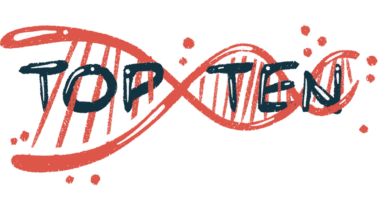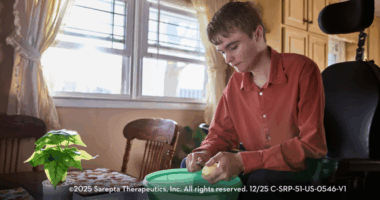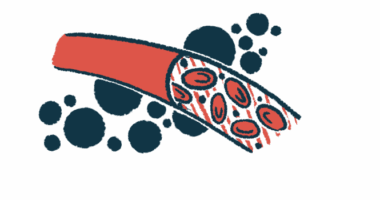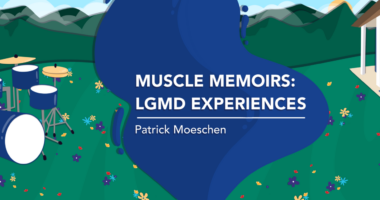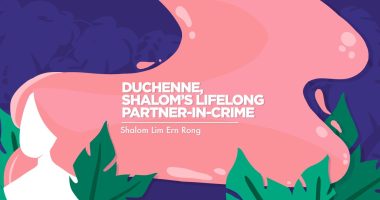Caring for someone with Duchenne MD: What caregivers should know
The more you know — from the stages of Duchenne to what to ask the doctor — the more prepared you’ll be for looking after a loved one with DMD
“Take him home and give him a good life.” This was the main advice given to Jessica and Chris Curran by a genetic counselor after their son, Conner, was diagnosed with Duchenne muscular dystrophy (DMD) eight years ago.
The Currans, who live in Ridgefield, Connecticut, knew there was no cure for DMD, a genetic disease that causes muscle degeneration and premature death. But they refused to believe that they could do little more than cherish whatever time they had with Conner, then 4 years old.
“I wasn’t looking for anyone to sugarcoat the diagnosis,” Jessica says. “I was just looking for a little hope. Instead, it felt like our lives were over.”
It’s a common (and normal) reaction many parents and caregivers have when they learn that the future they had envisioned for their family is going to be very different from what they imagined. But the Currans discovered the feeling didn’t last — and that thanks to advances in the treatment of DMD, there were reasons to be optimistic.
“Science is constantly evolving,” Chris says. “There is always hope.”
What is Duchenne muscular dystrophy?
DMD is the most common form of muscular dystrophy (MD), a group of more than 30 genetic diseases that causes progressive weakness and breakdown of skeletal muscles (those used in movement). The condition mostly affects boys.
Early signs of DMD, which usually appear around age 2 or 3, include difficulty sitting and standing independently, trouble getting up from the floor, and clumsiness.
While other types of muscular dystrophy cause similar symptoms, they often don’t appear until a child is in their teens, and some MD types don’t emerge until adulthood.
DMD typically progresses more rapidly and causes more severe symptoms than other forms of muscular dystrophy. While in the past treatment was mainly focused on managing symptoms, the outlook for people with DMD has improved dramatically thanks to advances in the understanding of the disease.
In the late 1980s, researchers discovered the gene that, when mutated, causes DMD. The gene mutations interfere with the production of dystrophin, a protein that is responsible for strengthening muscles — including those in the heart— and protecting them from injury. This is why people with DMD have muscle weakness and some develop heart problems.
Since then, more than 2,000 mutations in the DMD gene have been identified, allowing researchers to develop and test targeted therapies in a way that could slow disease progression.
For Jessica and Chris Curran, enrolling Conner in a clinical trial was one of their main priorities. With help from the Muscular Dystrophy Association, Conner became the first patient to be treated in a Pfizer clinical trial of a gene therapy aimed at improving muscle cell function.
While not a cure, the treatments have helped him maintain mobility. Conner, now 12, is still walking and running, defying expectations.
“Jessica and I knew we had to find a way to take the negative energy of Conner’s diagnosis and turn it into positive action,” says Chris, who, with Jessica, founded the nonprofit Kindness Over Muscular Dystrophy. “Advocating for him and supporting new research helped us get out of the dark place we were in right after we learned he had DMD.”
How DMD progresses
Because DMD progression varies for each child, doctors can’t predict what a child’s future will look like. But generally, DMD progresses in four stages:
- Early ambulatory (childhood): Children in this stage are walking and may be running, though at slower speeds and with a waddling gait.
Notable changes: Leg cramps, limited muscle flexibility, tiring easily, risk of falls, possible learning and speech difficulties. - Late ambulatory (late childhood/adolescence): Kids with DMD may still be walking but with greater difficulty. Sometimes they may need to use a scooter or wheelchair, especially when they are walking long distances.
Notable changes: Movements like climbing stairs and getting up from a seated position on the floor become harder, increased risk of falls, weakening of the muscles in the torso. - Early non-ambulatory (adolescence/early adulthood): Most children enter this stage around age 12, which is typically when they need to start using a wheelchair regularly.
Notable changes: Weakening arms, difficulty breathing, development of scoliosis (abnormal sideways curvature of the spine), enlarged heart (cardiomyopathy). - Late non-ambulatory (adults): By adulthood, most muscles are affected by DMD, including the heart and those that control breathing.
Notable changes: Difficulty maintaining posture and using the hands, trouble swallowing, more severe breathing problems (assisted ventilation becomes necessary), risk of heart failure.
Questions to ask your child’s doctor
Because a DMD diagnosis can be so unexpected, it’s not unusual for caregivers to have trouble making sense of the news, let alone knowing what they want to discuss with their child’s doctor.
“When my son Anthony was diagnosed, I didn’t even know what DMD was,” says Jill Anne Castle, who lives in Phoenix, Arizona, with Anthony, 23. He was diagnosed with DMD when he was 3 years old. “I was totally overwhelmed.”
You may need time to educate yourself about DMD and think about what you want to know. It can also be helpful to make a list of questions to bring to your appointments.
“There are no urgent decisions to be made right after they’re diagnosed, which gives caregivers time to process the diagnosis and learn more about the condition,” says Susan Apkon, MD, Fischahs Chair in Pediatric Rehabilitation and co-director of the Neuromuscular Program for Muscle Disorders at Children’s Hospital Colorado.
Questions you may want to ask your child’s doctor include:
- Are there clinics or hospitals near me that specialize in treating DMD?
- What kind of changes will I see in my child as the disease progresses?
- What type of specialists will my child need to see?
- How can I learn more about treatment options for DMD?
- Does my child need a genetic test?
- Is my child eligible for gene therapy?
- Should I consider enrolling my child in a clinical trial?
- Where can I find information about clinical trials that are recruiting patients?
- What kind of support is available for people with DMD and their families?
- How can I connect with other caregivers?
- How can I support my child’s social development and mental health?
- If I want to have another baby, will that child also have DMD?
The value of assistive devices
As a caregiver, it can be difficult to watch a child with DMD increasingly rely on assistive devices such as a wheelchair.
“Some think it’s a sign they’ve failed somehow, though it’s simply how DMD progresses,” Apkon says.
But children often react quite differently. “When I talk to children about using a wheelchair, their eyes light up and I get a big smile,” Apkon says. “For them, a wheelchair is a way to be more independent, and it reduces their fear of falling.”
In the first stage, Duchenne muscular dystrophy assistive devices generally focus on orthotics, which are used to help retain range of motion at the ankles. As kids become less steady on their feet and the risk of falls rises, they will require mobility devices, such as walkers, motorized scooters, and wheelchairs.
Assistive devices such as toilet chairs and bath seats can help them care for themselves and still have privacy. And thanks to advances in technology, such as voice activation, special-purpose computers, and screen readers, DMD patients who have lost much of their mobility can still do many of the things they used to do including type, play video games, and so much more.
“A lot of these technologies were not invented with disabled people in mind,” Apkon says, “but they’ve opened up new worlds for those who are.”
How to find support groups
Your child’s care providers may be able to recommend local support groups to share information and meet others who are caring for children with DMD. There are several online resources as well, such as:
- Muscular Dystrophy Association (MDA), a nonprofit focused on advancing research and care, as well as advocacy and education for the MD community.
- Parent Project Muscular Dystrophy (PPMD) Connect, which directs caregivers to local support groups and national awareness and advocacy campaigns.
- Cure Duchenne Cares, which offers in-person and virtual events and workshops for people living with DMD and their caregivers.
- Jett Foundation, a fundraising organization that provides family workshops, community webinars, and local and national events to support caregivers and families.
- Muscular Dystrophy News Today, which has columns, news, and community forums for patients and caregivers.
More information on support and resources for the DMD community is available here.
Staying healthy as a caregiver
When you’re so focused on the needs of the person you are caring for, it’s easy to stop paying attention to your own health. You may even have feelings of guilt for looking after yourself, but neglecting your health can lead to burnout. Symptoms of burnout range from being easily irritated to sleep problems to feelings of hopelessness to alcohol and drug misuse.
Mental healthcare is particularly important for DMD caregivers, who are at an increased risk for depression and anxiety. Castle, who struggled with unhealthy behaviors such as alcohol misuse for several years in the wake of Anthony’s diagnosis, says she regrets not seeking help sooner.
Thanks to therapy and getting sober, Castle says she no longer allows Anthony’s DMD to define her entire life. She also feels more capable as a caregiver.
“When you deal with your own pain, you’re better able to give the person with DMD the love and care they deserve,” Castle says.
Do’s and don’ts
Each caregiver’s experience handling a DMD diagnosis will be different, and learning to cope is an ongoing process. For those at the beginning of this journey, these tips can help reduce stress and move forward.
Do try to get care at a comprehensive neuromuscular clinic. “People with DMD need to see several types of specialists, such as neurologists and pulmonologists,” Apkon says. “Going to a clinic where your child can see many members of his care team in one day can save you a lot of stress and travel time.”
Don’t be hard on yourself for feeling angry, sad, or fearful. These are common reactions to a DMD diagnosis, so don’t feel guilty for experiencing these emotions.
Do be open and honest with your child about their condition. If you’re struggling to find an age-appropriate way to explain DMD, ask your doctor for advice. “Trying to hide the condition from a child is disrespectful to them, and keeping secrets adds to your own stress,” Apkon says.
Don’t be afraid to ask for help from friends and family. You’ll find that many people are eager to contribute. However, they often don’t know how to help, so be specific about the type of assistance you need.
Do know that DMD doesn’t stop caregivers and patients from leading fulfilling lives. “When my son was diagnosed, no one told me that we could have a joyful life,” Castle says. “But we have lots of fun and adventures, and we’ve met so many amazing, supportive people as we’ve navigated life with DMD.”
Muscular Dystrophy News Today is strictly a news and information website about the disease. It does not provide medical advice, diagnosis or treatment. This content is not intended to be a substitute for professional medical advice, diagnosis, or treatment. Always seek the advice of your physician or other qualified health provider with any questions you may have regarding a medical condition. Never disregard professional medical advice or delay in seeking it because of something you have read on this website.
About the Author

Jessica Brown has been a writer and editor for more than 20 years. While she has covered everything from psychology to child development, health is her specialty, with a focus on translating complex medical information into advice everyone can understand. She graduated from New York University, is a certified personal trainer, and has a medical writing certificate from the University of Chicago. She currently lives in Nanuet, New York.
Recent Posts
Related Articles

 Fact-checked by
Fact-checked by 
